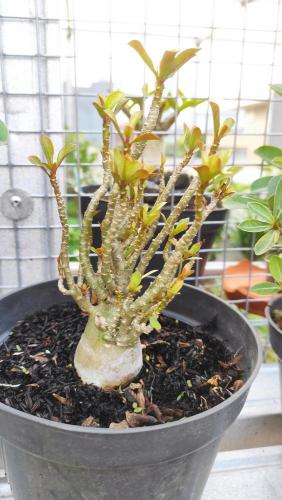I bought a beautiful and strange Adenium last Monday, this adenium has a lot of branches and the size of the leaves are very small, normal adenium leaves are 6 to 10 cm, this one is 0.5 to 1 cm, as you can see in the photo, side by side comparison with my other baby adenium. The seller said this one is 4 to 5 years old, roughly 6 inch tall.


Further researched show that the species is Adenium petit(e) green, and another species Adenium Magic Red Dragon that has exactly the same characteristics.
They are the creation of Suttikarn Jiamrattanaprateep (Mr. Koong) from Thailand ( people here appreciate him as father of Adeniums, like TCT of aloes). While searching for this species, I found information that this species was infected by virus, eventhough Mr. Koong said that he made this by applying radiation to the plant.
Why we said this is a virus infected species, because if we graft this species to other rootstock, the characteristics can spread to the mother plant, the rootstock will become multibranches and all leaves will become small. There was one nursery in Indonesia said that he get rid of all those species, worried that the virus will infect the rest of his adeniums.
Not much information that I can find about them, this website has some information, in Russion language, need the browser to automatically translate the content into English.
https://adenium.ucoz.ru/publ/7...
There are 2 questions that I am not very clear:
- Is the virus transmission at the plants airborned ?
- What is the chance that the virus transmitted to other genus like fruits, cactus & other succulents ?
I am not worry too much on the virus transmissions, just want to understand and be ready, infact next year I will try to infect the virus into some plants that I want to make into bonsai. Have traced the information on this species back to the news in 2007, so far did not see any scary story in the last 15 years. It is still considered rare plant here, the market price also quite high, 10 times of multi-petalled adeniums.
While searching the information, I also find out that a lot of variegated plants also because of virus infection. If we keep the variegated plants without worry, then we should not be too worry about this plant also.

